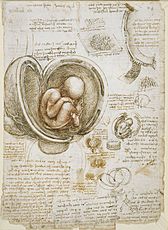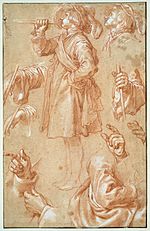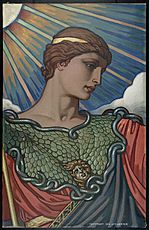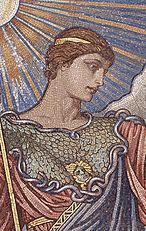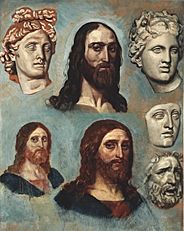Study (art) facts for kids
In art, a study is like an artist's practice or a rough draft. It's a drawing, sketch, or painting made before the final artwork. Artists use studies to take visual notes or to try out ideas.
Studies help artists understand how to draw or paint different things. They use them to plan important parts of their final work. This includes things like light, color, shapes, perspective, and how everything is arranged (composition). Sometimes, these early studies can feel more exciting than the finished piece. This is because they show the artist's fresh ideas and discoveries. When you see how an artist changed their work, you can share in their journey of discovery. Notes written next to the drawings also help you understand the artist's thoughts.
Contents
What is a Study in Art?
A study is a preliminary artwork. It helps an artist explore a subject or prepare for a larger project. Think of it as an artist's sketchbook or a practice run. Artists often make many studies before they start their main artwork.
Why Do Artists Create Studies?
Artists create studies for several reasons:
- Practice: They practice drawing or painting different objects. This helps them get better at their skills.
- Understanding: Studies help artists understand how light falls on an object. They also learn about its shapes and colors.
- Planning: Artists plan how to arrange elements in their final artwork. This includes deciding on the best viewpoint and composition.
- Experimenting: They try out different ideas or techniques. This helps them see what works best before committing to a big piece.
Famous Studies in Art History
Studies have been important for a long time. We can find them as far back as the Italian Renaissance. Art historians have kept some of Michelangelo's studies.
For example, Michelangelo made a study for the Libyan Sibyl. This is a figure on the ceiling of the Sistine Chapel. Interestingly, his study was based on a male model. But the final painting shows a woman. Details like these help us understand how famous artists thought and worked.
- Studies by Famous Artists
-
Leonardo da Vinci's study of embryos, around 1510-1513.
-
Studies by Abraham Bloemaert, around 1626.
-
Head of Minerva, by Elihu Vedder, 1896. This was a study for a larger work.
-
Alexandr Ivanov, a study of Christ's head.
Studies also inspired some of the first conceptual art in the 20th century. In conceptual art, the creative process itself is the main focus. This means the journey of making the art is more important than the finished object.
See also
 In Spanish: Estudio (pintura) para niños
In Spanish: Estudio (pintura) para niños


